Since the creation of YouTube in 2005, the online video content world has taken a huge turn in many aspects. Although YouTube continues to be an unmatched video sharing giant, with more than 2.4 billion of active users around the world, more and more content creators, businesses, and viewers are looking for alternatives on YouTube which would be more related to their needs and principles. Alternatives to YouTube have become more active during the recent years because of some reasons that are connected with adjustable algorithms, monetization, limitations of content, and a willingness to have more space in the expression of ideas. If you are a creator who wants to expand the presence of your content on more platforms, or a business searching higher video hosting services, or a viewer who is sick of annoying advertisements, you can go and discover the opportunities and experiences of ]alternatives.
So, in the full listing, we are going to discuss the 12 best YouTube alternatives you should use in 2025, describing their peculiarities, monetization opportunities, and audience directions. Vimeo and Dailymotion are long-established ]alternatives and rather solid platforms, whereas Odysee is a relatively young blockchain-driven solution. Each of these platforms has its own benefits and may be a dream come true in terms of your video content plan.
Why Consider a YouTube Alternative?
Algorithm Dependency and Unpredictability
The algorithm employed by YouTube is advanced but it is also unreliable and messy with creators. Sudden loss of viewers, demonetization with no reasons, or even shadowbing without obvious explanations have been observed by numerous content creators. Alternatives to Youtube are frequently more open in where their content is found, enabling creators to have greater control over their audience or viewership.
Monetization Challenges
The requirements to monetize through YouTube have also become quite demanding as a channel must have an audience of at least 1,000 subscribers and 4,000 watch hours in order to participate in the Partner Program. Numerous alternatives to YouTube also have easier monetization, meaning that creators can begin earning through lower viewership numbers or with the help of alternative monetization models, such as cryptocurrency rewards or direct patronage.
Content Restrictions and Censorship Concerns
The reason being that the community rules created by YouTube to ensure a safe platform are sometimes over-regulatory or may lack quality, enforcement and uniformity. Authors covering controversial subjects, educational materials on sensitive issues, or narrow networks usually have their materials flagged or deleted. A number of alternatives are defined as free speech platforms where content rules are less strict.
Professional and Business Needs
YouTube alternatives in business and education contexts can have better professional functionality with higher privacy levels, the absence of advertisements, high-level analytics, and white-label services. These sites are specific to those organizations that would require greater control over video content distribution and viewership.
Types of YouTube Alternatives
General Video Sharing Platforms
The working activities are similar to the activities of YouTube, as its alternative sites provide rather general content categories and attraction to the mass audience. Social video sharing sites such as Dailymotion and Vimeo fit this category, although their UI is easy to use and familiar due to the interface in common with YouTube, they do provide custom features that makes them uniques among them. These platforms usually sustain all types of contents and command a huge and diverse number of users.
Niche-Specific Platforms
Other alternatives on YouTube concentrate on certain content niche or audiences. An example is Twitch, a site that is mainly used in serving the needs of the gaming community through live streaming services, whereas Crackle caters to the needs of entertainment. These niche YouTube metas would offer greater tools and audiences of users in their particular niches.
Decentralized and Blockchain-Based Platforms
alternatives on a new generation, are making use of blockchain technology and decentralized networks in order to provide creator ownership, use of cryptocurrencies as rewards, as well as censorship-free options. Candidates such as DTube and Odysee are platforms, which offer new models of monetization as well as distribution models of content.
Professional and Business-Focused Platforms
Professional users can use YouTube substitutes such as VdoCipher and Vimeo Business that provide advanced security options, branding ability, and enterprise support. These services focus more on functionality as opposed to being viral, thus they suit businesses, educational institutions and professional content creators.
Live Streaming Platforms
Although YouTube also supports live streaming, specialized alternatives (such as Twitch and Rumble) might have a better in-due-time streaming-support as well as better audience possibilities and communities that support native programs constructing around live content creation in general.
Key Features of a Good YouTube Alternative
User-Friendly Interface and Navigation
The top YouTube alternative platforms are those, which retain user friendly pages without significant learning processes. The ability to upload, discover, and use should be made easy without frustrations by users. Without a doubt, such aspects are intuitive navigation, ordered structure of the content, and adaptation to different devices.
Content Discovery and Search Functionality
Could-be great alternatives to YouTube should enable high-quality search providers and the content discovery process. Regardless of algorithmic or category browsing or social features, users shall have no difficulties in finding relevant content. Open discovery-based approaches that do not entirely depend upon closed algorithms are especially helpful.
Monetization Options and Creator Support
The variety of monetization possibilities is one of the things that distinguishes the best YouTube alternatives and simple video hosting services. These are advertising revenue sharing, subscriptions, direct fan support, integrating merchandise and novel strategies such as cryptocurrency rewards. Also, creator support and obvious monetization policies are essential.
Technical Quality and Reliability
There are alternative services to YouTube which should be able to host, stream, and play videos. This comprises many kinds of video quality, quick load speeds, low downtime, and the compatibility of it on other devices and browsers. Technical stability directly impacts user experience and creator success.
Community Features and Engagement Tools
Healthy alternatives promote community forming via commenting, liking, sharing and other tools of engagement. Other platforms are more than simple interactions and have the community posts or enabled live chat or creator-fan interaction tools that increase the social dimension of video viewing.
Top 12 YouTube Alternatives
1. Vimeo
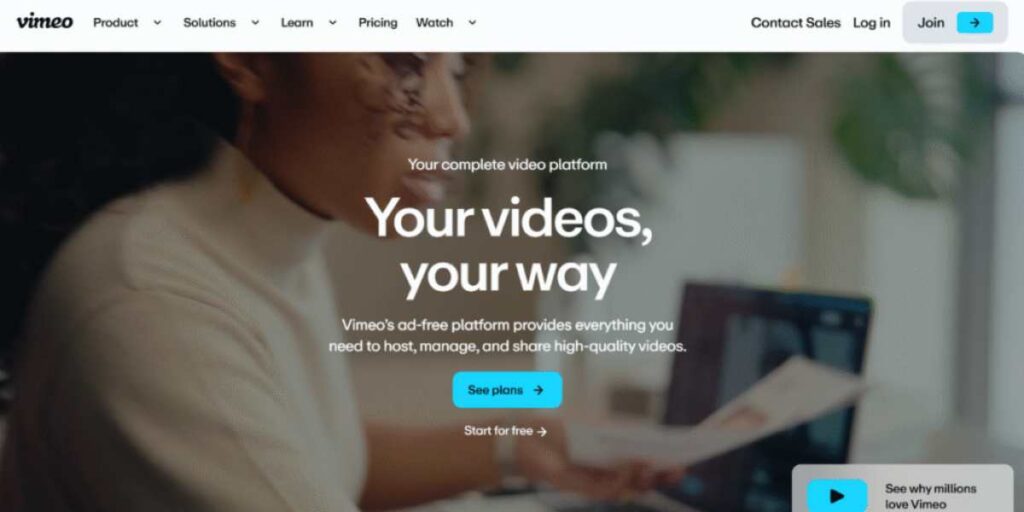
- Best For: Professional creators and businesses seeking high-quality, ad-free video hosting
- Website Link: http://vimeo.com
- Ratings: 4.2/5
Vimeo is among the oldest alternatives of YouTube that boasts of over 175 million subscribers in 150 countries. To this day, Vimeo has managed to establish itself as a superior video service that champions the idea of quality over quantity, due to which it is the platform of choice of professional videographers, artists, and businesses alike. The fact that the platform does not feature advertising and that they deliver high-quality content have made it the more refined version of YouTube.
Vimeo has several plans, starting with simple free plans and reaching the enterprise-level ones that have various storage capacities, personal settings, and professional features. Its minimalist design with little or no clutter shows that the platform emphasizes user experience and content more than they do the metrics of engagement.
Key Features:
- Advanced Privacy Controls: Password-protected videos, domain restrictions, and granular sharing permissions
- Professional Customization: Custom players, branded channels, and white-label solutions for businesses
- High-Quality Streaming: Support for 4K, HDR content with superior compression algorithms
What Kind of Content Works Best: Creative portfolios, corporate videos, and artistic content that benefits from ad-free presentation.
Monetization: Revenue sharing through Vimeo On Demand and direct sales of premium content.
Pros: Ad-free experience with superior video quality and professional features for serious creators.
Cons: Smaller audience reach compared to YouTube and higher costs for advanced features.
2. Dailymotion
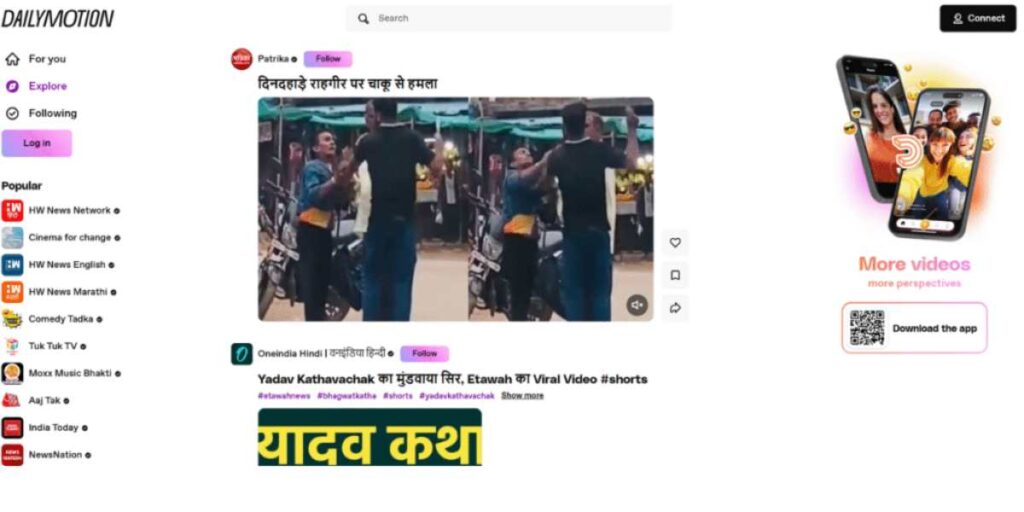
- Best For: International creators seeking a large, diverse audience outside of YouTube
- Website Link: http://dailymotion.com
- Ratings: 3.8/5
Dailymotion, which started in 2005 is one of the most popular alternatives to YouTube in the whole world where it has about 300 million unique users per month. Being a platform founded by the French, Dailymotion has held firm international footing, especially in the European countries and those parts of the world that YouTube has encountered restriction and competition.
The platform would provide a similar experience to a YouTube experience with its own identity locked onto various contents policies and discovery methods. Dailymotion has a 2 hours upload limit on videos per day with a total of 96 videos per day, these are great optimal limits to creators who keep it up.
Key Features:
- International Reach: Strong presence in European and emerging markets with localized content
- Flexible Upload Limits: Generous daily upload allowances compared to other YouTube alternatives
- Age-Gate Protection: Advanced content filtering and parental controls for sensitive material
What Kind of Content Works Best: International content, news, and entertainment that targets non-English speaking audiences.
Monetization: Partner program with advertising revenue sharing and premium content options.
Pros: Large international audience with less competition than YouTube for discovery.
Cons: Interface feels dated and monetization opportunities are limited compared to other platforms.
3. Rumble
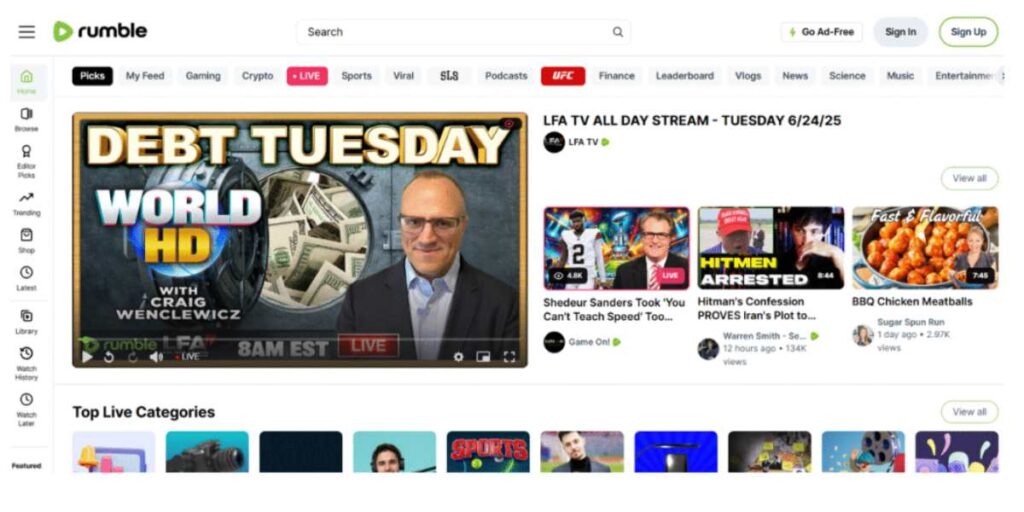
- Best For: Creators focused on free speech and political content
- Website Link: http://rumble.com
- Ratings: 4.1/5
Started in the year 2013 by Chris Pavlovski, Rumble has become a major competitor to YouTube especially to the creators who want platforms that have fewer limits on what they can post. It received significant exposure in political scandal situations and controversial protests surrounding content moderation of the more mainstream platforms, so as to market itself as a free speech alternative.
The development trend of Rumble has been impressive, and various figure content creators and media people have switched to the service. The company has raised substantial capital and relationships, which proves that the company is adamant about making it big as a video hosting service provider.
Key Features:
- Creator-Friendly Monetization: Multiple revenue streams including ads, subscriptions, and direct support
- Free Speech Focus: Minimal content restrictions compared to other major platforms
- Rights Management: Creators retain full ownership and control of their content
What Kind of Content Works Best: Political commentary, news analysis, and content that may face restrictions on other platforms.
Monetization: Revenue sharing, subscription models, and direct creator support through various mechanisms.
Pros: Strong commitment to creator rights and free speech with competitive monetization options.
Cons: Smaller overall audience and potential association with controversial content may limit mainstream appeal.
4. Twitch
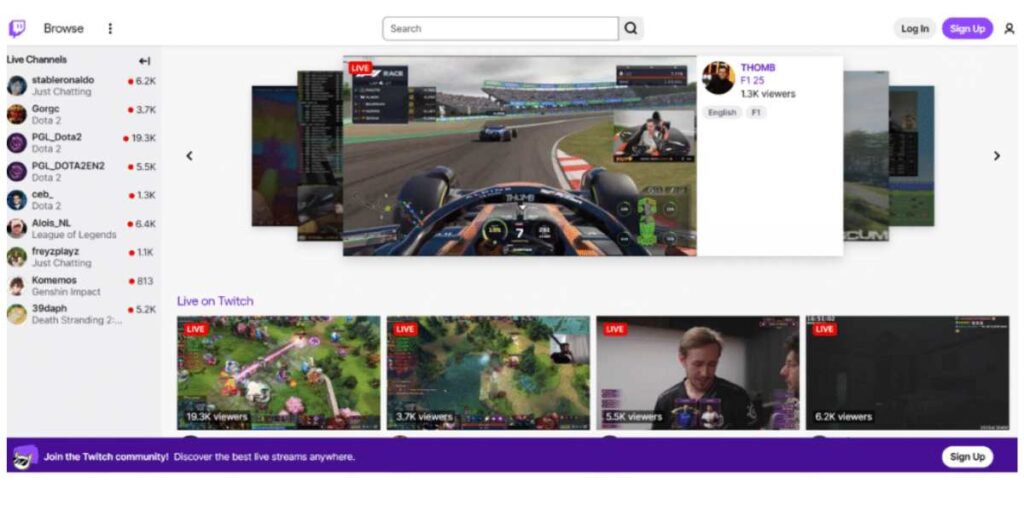
- Best For: Live streaming, gaming content, and real-time audience interaction
- Website Link: http://twitch.tv
- Ratings: 4.3/5
Twitch, being the live streaming platform of Amazon, has changed the way of producing content live, currently serving as the existing hub for gaming materials and gaining more and more popularity in the concept of Just Chatting, creative content, and real-time shows. Although it is not a direct alternative to YouTube in classic video uploads, with its live-first presentation, Twitch provides unusual opportunities of interaction between the creator and their viewers.
This system is even more monetized in terms of the integration with Amazon ecosystem with its merchandise and game sales and prime subscriptions. The interactive culture of Twitch that revolves around chat makes highly engaged community around an individual streamer.
Key Features:
- Interactive Live Streaming: Real-time chat, polls, and audience participation features
- Gaming Integration: Seamless connection with gaming platforms and merchandise
- Community Building: Strong tools for building dedicated follower communities
What Kind of Content Works Best: Live gaming, real-time interaction shows, and community-focused content.
Monetization: Subscriptions, donations, advertising revenue, and affiliate marketing through Amazon integration.
Pros: Unmatched live streaming capabilities with highly engaged audiences and multiple monetization streams.
Cons: Limited options for pre-recorded content and steep learning curve for new streamers.
5. Odysee
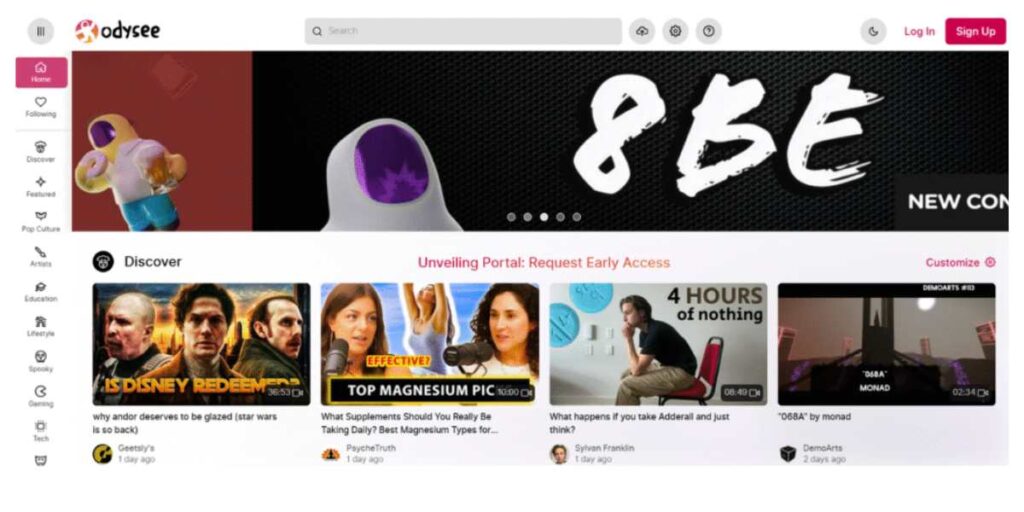
- Best For: Blockchain enthusiasts and creators seeking decentralized content distribution
- Website Link: http://odysee.com
- Ratings: 3.9/5
Odysee is one of the latest generations of blockchain-based alternatives to YouTube, which appeared in 2020. Odysee is also based on the LBRY blockchain protocol and has features of rewarding content creators with cryptocurrencies along with the ability to distribute the storage capabilities of the content so that it is not easily censored and erased by central entities.
The platform is an assemblage of video hosting functionality and blockchain innovation, which provides creators the possibility to receive LBRY Credits (LBC) depending on the interest and support of the community. In such a way, this model will attract innovators who are interested in cryptocurrency and the creators who need an alternative to the traditional monetization mechanisms.
Key Features:
- Blockchain-Based Rewards: Earn cryptocurrency through content creation and engagement
- Decentralized Storage: Content stored across distributed networks for enhanced security
- Censorship Resistance: Reduced risk of content removal due to decentralized architecture
What Kind of Content Works Best: Tech content, cryptocurrency discussions, and content that values decentralization and censorship resistance.
Monetization: LBRY Credit rewards, tips, and traditional advertising options.
Pros: Innovative monetization through cryptocurrency and strong censorship resistance.
Cons: Smaller user base and learning curve associated with blockchain technology.
6. DTube
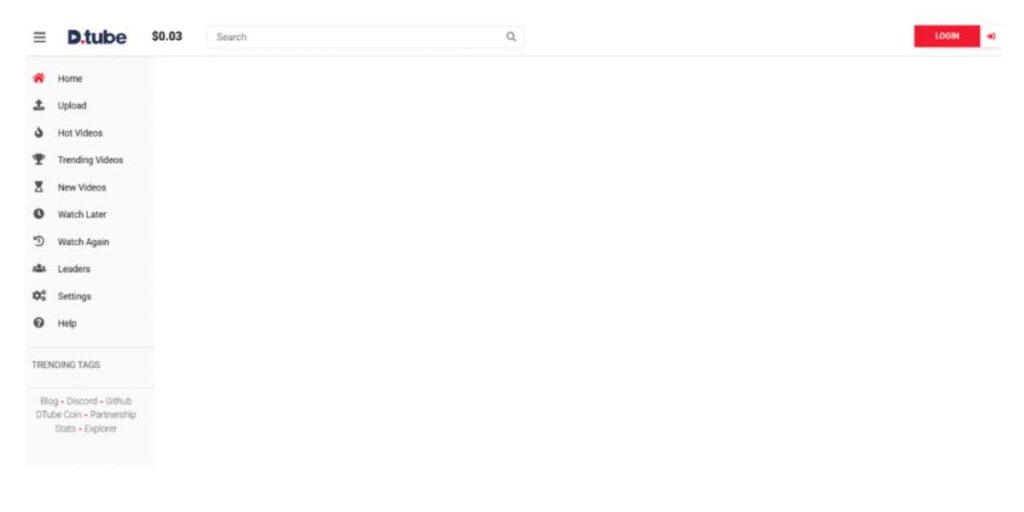
- Best For: Cryptocurrency enthusiasts and creators seeking community-driven monetization
- Website Link: https://d.tube/
- Ratings: 3.6/5
DTube (Decentralized Tube) is a video web site where the community decides what videos to upvote, which is being rewarded with cryptocurrency depending on how much the community likes you. In operation since 2016, DTube is one of the first blockchain experiments of video platforms.
The main distinction, unlike other well-known examples of YouTube alternatives, is that DTube does not count the number of views, but rather concentrates on community voting, this way, building a unique ecosystem where the quality of content and community activities directly correlate with rewards to creators.
The ability to browse the platform with no ads as well as the content discovery model, which relies on the voting, stands out among the alternatives.
Key Features:
- Vote-Based Rewards: Creators earn cryptocurrency based on community votes rather than views
- Ad-Free Experience: No advertising interruptions for viewers
- Immutable Content: Once uploaded, videos cannot be deleted due to blockchain storage
What Kind of Content Works Best: Content that resonates with cryptocurrency and blockchain communities.
Monetization: Cryptocurrency rewards based on community voting and engagement.
Pros: Unique community-driven monetization model with ad-free viewing experience.
Cons: Very limited audience and dependency on cryptocurrency market fluctuations.
7. PeerTube
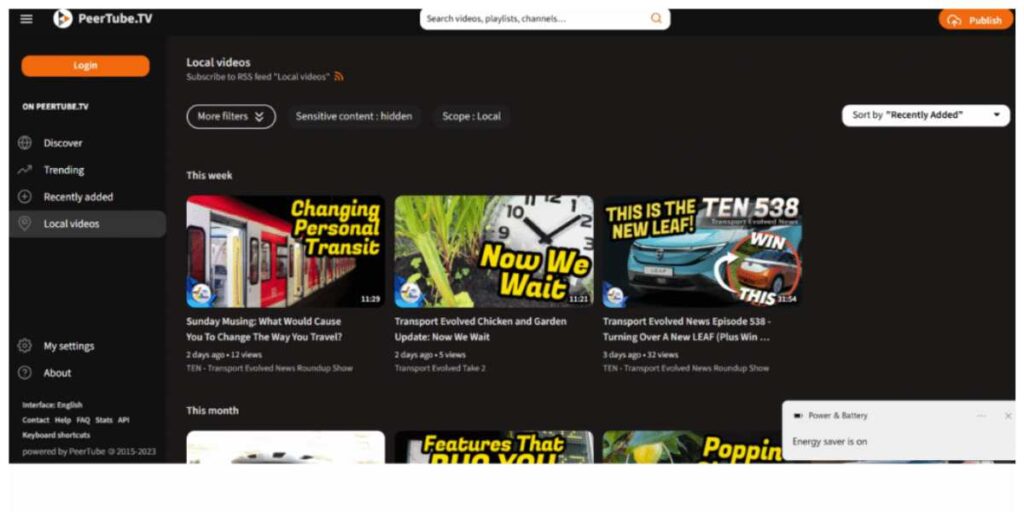
- Best For: Privacy-conscious users and open-source enthusiasts
- Website Link: http://joinpeertube.org
- Ratings: 3.7/5
PeerTube is a federated video hosting protocol where several independent servers make up a vidding network with interconnected video platforms. Active since January 2021 and present in 28 languages, PeerTube is a peer-to-peer-based video hosting platform with an enhanced content delivery infrastructure to distribute a load across the network.
Being an open-source platform, PeerTube can enable groups and organizations to run their own instance but still within the wider federation of PeerTube. In this method, there is greater than ever control of content policies, moderation and community management.
Key Features:
- Federated Network: Multiple interconnected instances creating a diverse ecosystem
- Peer-to-Peer Streaming: Reduced server load through distributed content delivery
- Complete Privacy: No tracking or data collection with full user control
What Kind of Content Works Best: Privacy-focused content and communities that value decentralization and open-source principles.
Monetization: Varies by instance, with some offering donations or subscription models.
Pros: Complete privacy protection with no tracking and federated approach ensuring content diversity.
Cons: Complex setup for creators and fragmented user experience across different instances.
8. Flickr
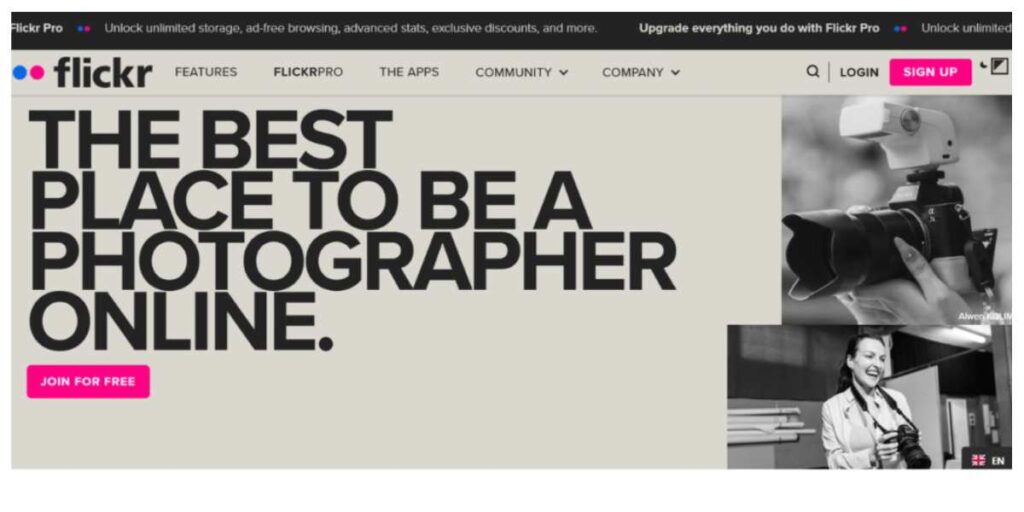
- Best For: Photographers and creators sharing both images and videos
- Website Link: http://flickr.com
- Ratings: 4.0/5
Although Flickr is mainly considered a photo-sharing platform, it has expanded to become one of the possible YouTube alternatives to use in case one operates with both photos and videos. Flickr is in operation since 2004 and has more than 60 million people visiting the site monthly; it presents a special content sharing proportion.
The platform also accommodates video uploads of up to 1GB and a maximum of 90 minutes, which is good enough to accommodate creators who would like to have their photography and videography in the same platform. The community based policy of Flickr is enticing to both creative artisans and amateurs.
Key Features:
- Dual Media Support: Seamless integration of photos and videos in one platform
- Creative Community: Strong community of photographers and visual artists
- Flexible Privacy Controls: Granular control over content visibility and download permissions
What Kind of Content Works Best: Photography tutorials, creative portfolios, and visual storytelling that combines images and video.
Monetization: Flickr Pro subscriptions and print sales through integrated services.
Pros: Unique photo-video combination platform with strong creative community.
Cons: Limited video-specific features and competition from Instagram for visual content.
9. Wistia
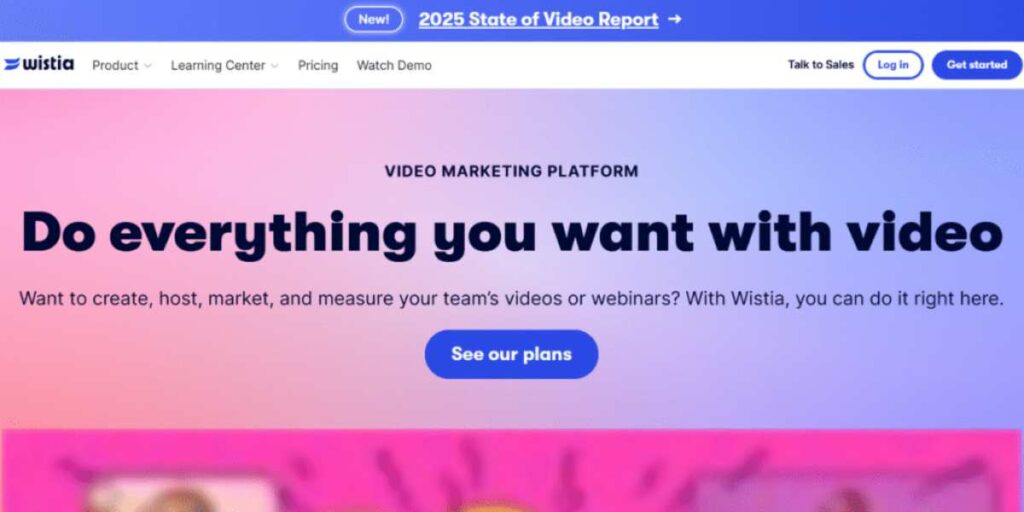
- Best For: Businesses, marketers, lead generation, professional video hosting with advanced analytics.
- Website Link: https://wistia.com/
- Ratings: 4.5/5
Wistia is a video hosting service yet another service that is intricately crafted to serve the needs of businesses and marketers. Wistia is not an ordinary video-sharing platform like other sites in the market because it aims at helping organizations to utilize video services as a marketing tool, a sales tool, an internal communication tool, or even a customer engagement tool. It is unique in its arsenal of sophisticated functions that involves data analytics, lead capture and brand customization.
Wistia enables companies to simply control the quality of video on their servers without the advertisements so that the video can be more comfortable and without pages like YouTube. Although all the solutions above match the core requirements of a CRM-integrated video platform, what makes it so reliable it to give hues into the behavior of their viewers in details so that they can know what connects to their audiences.
Key Features:
- Unlimited Video Length: No restrictions on video duration for uploads
- Studio Content Partnerships: Access to professional content from independent producers
- Customizable Streaming: Various quality options and streaming customizations
What Kind of Content Works Best: Long-form documentaries, educational series, and extended entertainment content.
Monetization: Advertising revenue sharing with limited premium content options.
Pros: Unique unlimited video length feature ideal for long-form content creators.
Cons: Excessive advertising and limited modern features compared to other platforms.
10. Internet Archive
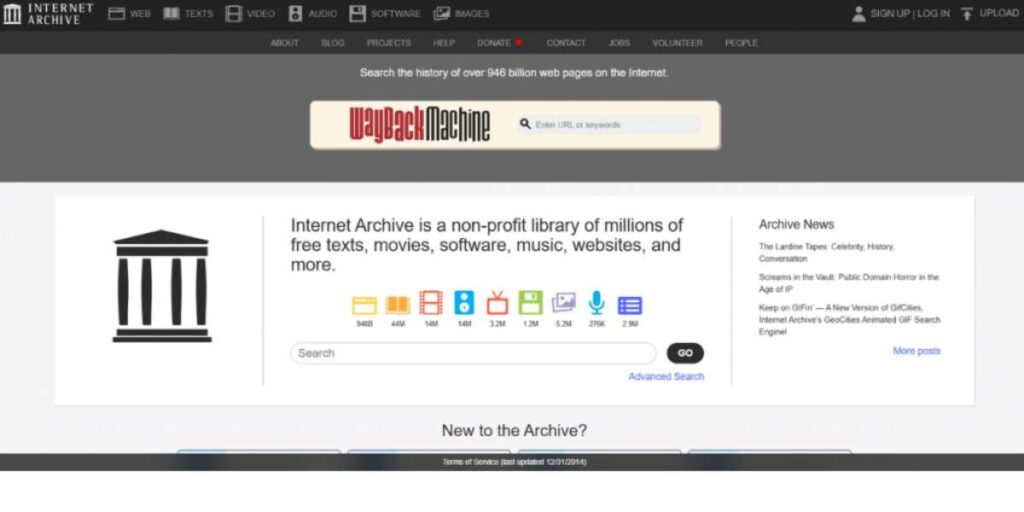
- Best For: Archival content, educational videos, public domain films, historical footage.
- Website Link: https://archive.org/
- Ratings: 4.5/5
The Internet Archive is a colossal non profit digital library that also works with an aim of free public access to digitalized book materials in the world. It is infinitely more than a video site it is an enormous sunken treasure of human knowledge and creativity, containing billions of web pages (school memory banks), millions of books, audio recordings, software, photographs and and, most importantly, a zillion videos.
Whereas a commercial video-streaming service could have an economic incentive to focus on popular trends or monetizing creators, the preservation and accessibility of the video material is the main goal at the Internet Archive. The Internet Archive becomes a valuable tool to a researcher, teacher, historian, or to anybody willing to explore historical events, old media, or works under the public domain.
Key Features:
- Completely Free Access: No subscription fees with ad-supported model
- Professional Content Library: Curated movies, shows, and original programming
- Multi-Device Support: Available across mobile, desktop, smart TVs, and streaming devices
What Kind of Content Works Best On This Platform: Historical footage, documentaries, old films, classic TV shows, educational materials, independent archives.
Monetization: None directly for creators; relies on donations to maintain the archive.
Pros: Free, ad-free, vast collection of unique content, valuable for research and education.
Cons: Not a platform for new, viral content, limited community features, interface can be less modern.
11. Nebula

- Best For: Creators focused on educational, analytical, and long-form content with full creative freedom
- Website Link: https://nebula.tv
- Ratings: 4.2/5
Nebula is an independent video streaming platform built by and for creators, especially those in the educational and intellectual space. Launched by popular YouTubers in collaboration with CuriosityStream, Nebula gives creators full control over their content, monetization, and audience. It’s ad-free, subscription-based, and curated—meaning no algorithms interfere with what viewers see. Creators can publish exclusive content, early access videos, and experimental projects without worrying about platform penalties or demonetization.
Key Features:
- Ad-Free Experience: Entirely subscription-funded, no advertisements or algorithm-based content suppression
- Creator-Owned Platform: Built and governed by creators, giving them autonomy and higher revenue control
- Exclusive & Early Content: Space for creators to test new formats or release content ahead of YouTube
What Kind of Content Works Best: Educational content, in-depth explainers, video essays, and creator-led documentaries
Monetization: Subscription-based model; creators are paid based on engagement, watch time, and bonus partnerships
Pros: No ads or algorithm interference, higher content freedom, built-in audience from CuriosityStream collaborations
Cons: Only available to invited or partnered creators, viewer base smaller than YouTube’s
12. BitChute
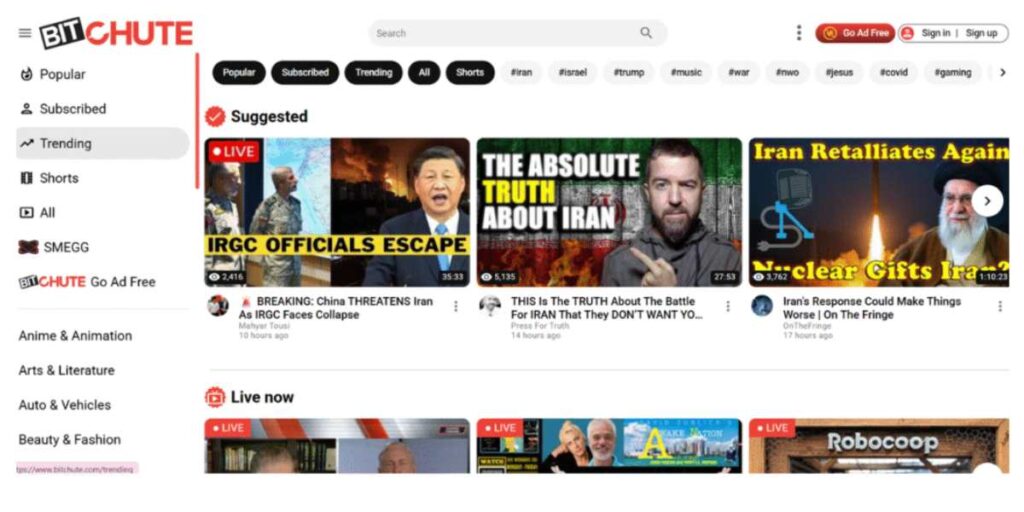
- Best For: Creators prioritizing free expression and minimal content restrictions
- Website Link: http://bitchute.com
- Ratings: 3.3/5
BitChute, which began operating in 2017, is behind this trend, following a philosophy of creators first, which uses peer-to-peer technology to deliver video. This platform became known because of its use as an alternative to YouTube, since it supports free speech and shows content moderation only to a minimal extent, which is especially attractive to creators that feel they have been limited by the policies of the popular platform.
A peer-to-peer model used by BitChute lowers the cost of hosting and builds a more robust system of distributing content. It has the option of registration with no client requirements to register before viewing and digesting its materials.
Key Features:
- Peer-to-Peer Technology: Distributed content delivery reducing central server dependency
- Minimal Registration Requirements: Optional account creation for content consumption
- Creator-Centric Policies: Platform policies prioritizing creator expression and content freedom
What Kind of Content Works Best: Alternative news, political commentary, and content that may face restrictions on mainstream platforms.
Monetization: Direct creator support and payment systems integrated into the platform.
Pros: Strong commitment to free expression with innovative peer-to-peer technology.
Cons: Limited audience reach and potential association with controversial content.
Monetization Opportunities and Creator Support on These Platforms
Traditional Advertising Models
Most of the alternatives to YouTube such as Dailymotion, Rumble, Utreon have the traditional advert-revenue sharing model just like YouTube does. Nevertheless as these platforms tend to do better monetization deals or have less demanding entry standards, monetization may be available to smaller content producers. The major strength may be that there is usually less competition over advertisement funds as there are in the market of YouTube.
Subscription and Direct Support Systems
Such services as Vimeo or Twitch have developed subscription-based business models to establish intimate relationships between artists and audiences. Such systems also tend to yield more revenue on a per-viewer basis than pure advertising approaches, since hardcore admirers will happily pay up to get high-quality content or to contribute to it.
Cryptocurrency and Blockchain Rewards
Video streaming platforms such as Odysee and DTube are new and innovative video streaming services that allow monetization through cryptocurrencies with creators receiving digital coins depending on user interaction levels and quality of content posted. Although the systems provide the potential payoff and democraticity when it comes to the promotion of the content, they also bring the volatility and non-suitable-ness to all creators.
Premium Content Sales
There are also a number of YouTube alternatives, especially Vimeo that allow selling the content directly from the video through the direct e-commerce mechanisms. This model is ideal in educational content, special dummies and high quality valuable creative content that the audience is willing to upgrade to access premium content.
How to Choose the Right YouTube Alternative
The best way to choose the best YouTube alternative is to take your objectives, needs, and content type into consideration. This choice is to be made by a systematic consideration of some of the major factors which go well with your creative and business goals.
Define Your Primary Goals
Before exploring specific platforms, clearly identify your primary objectives. Do you want wider followership, improved monetization, freedom of creativity, professional capabilities, or privacy? Selecting of your platform should have your main objective as different YouTube alternatives will compete in various customer areas.
Assess Your Content Type and Audience
Specific alternatives to YouTube can be better applied to certain types of content as they attract different audiences. Videos about gaming have a great success on Twitch, professional videos on Vimeo, and political commentary on Rumble. Examine your writing style and audience to find out the outlets that will suit your writing.
Evaluate Monetization Requirements
Consider both immediate and long-term monetization needs. When you require quick money-making, less-demanding platforms or other methods of gaining money (check them out before the period of absence is over) could be better. To promote a brand development on the long-term basis, more valuable platforms can be selected with the professional functionality and audience building tools.
Consider Technical Requirements
Evaluate your technical requirement such as the potential video quality, upload restrictions, storage demand, and integrational demands. Experienced originators could require sophisticated capabilities such as personal players, statistics, and/or access to their APIs whereas first-time creators might be concerned with ease-of-use.
Platform Stability and Growth Potential
Evaluate the long-term viability of potential alternatives. Take into account such aspects as financial support, user expansion rates, feature creation, and strategy of the platform. Audience building on any platform is costly and thus it is important to select platforms that are stable and on an upward growth.
Conclusion
The environment of YouTube alternatives in 2025 is promising opportunities to content creators, businesses, and viewers who are trying to find alternatives to the ruling platform on a scale that has never been experienced before. Whether it is through a long-established video sharing platform, such as Vimeo or Dailymotion, or a more creative alternative such as Odysee or DTube, which utilize the power of blockchain-based applications, each of the platforms offers its own benefits and concerns certain needs in the general video content space.
The success with the alternatives to YouTube does not depend on whether you can find an ideal substitute to YouTube, it is necessary to choose the platforms that would not break the points of your interests, the purpose of your content, and the needs and likes of your audience. Numerous tangibly achieved developers have found that more platform expansion is better than reliance upon one alternative where they can achieve the impetus of both audience reach, the ability to creatively produce and have the ability to recompense.
Also Read: Best TikTok Alternatives
FAQs
Can I use multiple YouTube alternatives simultaneously, or should I focus on one platform?
There is no good reason why one ever needs to use only one type of YouTube alternative, as long as one has more than one to use, it is a good idea as a serious content producer. A variety of benefits such as less reliance on a specific platform, ability to reach a different targeted audience, and financial channels are associated with this multi-platform strategies, which are commonly referred to as content distribution diversification.
Which are the most monetizable alternatives to small creators?
A number of YouTube alternatives are easier to monetize than YouTube which have stringent monetisation conditions. Rumble allows revenue sharing with not-so-high entry barriers, and Odysee rewards users in crypto depending on their activities instead of subscribers. The community-voting system of DTube ensures that creators can receive immediate rewards in the form of payouts depending on the quality of content and the donation-based and subscription-based monetization of Twitch will provide creators with an unrestricted opportunity to make money regardless of their following numbers.
Can the alternative of YouTube also be secure against content deletion and the modification of the platforms policy?
No channel can promise full protection against censorship and the introduction of new policies, although some of the platforms that are an alternative to YouTube are more secure than others. The most resistant and impenetrable to censorship are the platforms built using blockchain technologies such as Odysee and DTube which conduct their operations in a decentralized network. Nevertheless, they will have to adhere to the law and can apply some rules of content.
What are the viewerships on YouTube alternatives compared to YouTube and does it make any difference?
There are smaller audiences in the alternative of YouTube in comparison to the 2.4 billion YouTube users. Dailymotion boasts 300 million, with Vimeo registering 175 million, and newer destinations (such as Rumble and Odysee) having considerably lower numbers of users. However, smaller audience size doesn’t necessarily mean less opportunity.
What are my technical requirements as far as being successful on the YouTube alternatives as compared to being successful on YouTube?
The acquisition of the most basic forms of technical skills that are necessary to use YouTube is needed on most alternatives; there should be video editing, thumbnail making, and simple knowledge of content optimization. However, some platforms require additional skills. Social networks such as Odysee (Blockchain-based alternative of YouTube) and DTube work on the principle of of basic knowledge of cryptocurrencies.

